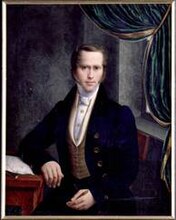Johann Friedrich Welsch
Johann Friedrich Welsch (* 1796 Wesel ; † 1871 ) was a German painter and restorer .
life and work
The son of a Wesel painter and glazier received his first drawing lessons as a student at the Higher Citizens' School in Wesel . From 1817 he studied in Berlin, where he received a solid technical education which later enabled him to work as a successful restorer. From 1823 to 1824 he taught himself as a drawing teacher at his former school in Wesel.
Around 1827 he married Caroline Wirtz, who was born in Duisburg, for the second time. The couple's two sons, Karl Friedrich Christian Welsch (* 1828) and Julius Maria Jakob Welsch (* 1832), both born in Wesel, became well-known painters themselves.
Around 1835 Welsch went to study at the drawing academy in The Hague , where he also worked as a teacher from 1836 to 1839.
In the 1840s, Johann Friedrich Welsch settled in Münster . He painted history pictures , landscapes and portraits . And he restored among others 1851/1852 comprising the three-winged altarpieces in the Propsteikirche Dortmund of Derik Baegert and 1870 in the collegiate church Cappenberg the altar with pictures of the Passion and the life of Mary of January Baegert . At that time, both works were not yet associated with their Wesel painters, but were known under emergency names , such as for Jan Baegert the master of Cappenberg .
literature
- Welsch, Johann Friedrich . In: Hans Vollmer (Hrsg.): General lexicon of fine artists from antiquity to the present . Founded by Ulrich Thieme and Felix Becker . tape 35 : Libra-Wilhelmson . EA Seemann, Leipzig 1942, p. 361 .
- Johann Friedrich Welsch: Complete instructions for restoring the paintings in oil, wax, tempera, water, miniature and pastel colors…. Verlag Gottfried Basse, Quedlinburg / Leipzig 1834 ( reader.digitale-sammlungen.de ).
Web links
- Johann Friedrich Welsch, short biography with portrait , on Wesel, city portrait, accessed on September 13, 2015
- Johann Friedrich Welsch , on Artnet, accessed on September 13, 2015
Single receipts
- ↑ Johann Friedrich Welsch, Biographical Notes , on biografischportaal.nl, accessed on September 13, 2015.
| personal data | |
|---|---|
| SURNAME | Welsch, Johann Friedrich |
| BRIEF DESCRIPTION | German painter |
| DATE OF BIRTH | 1796 |
| PLACE OF BIRTH | Wesel |
| DATE OF DEATH | 1871 |
